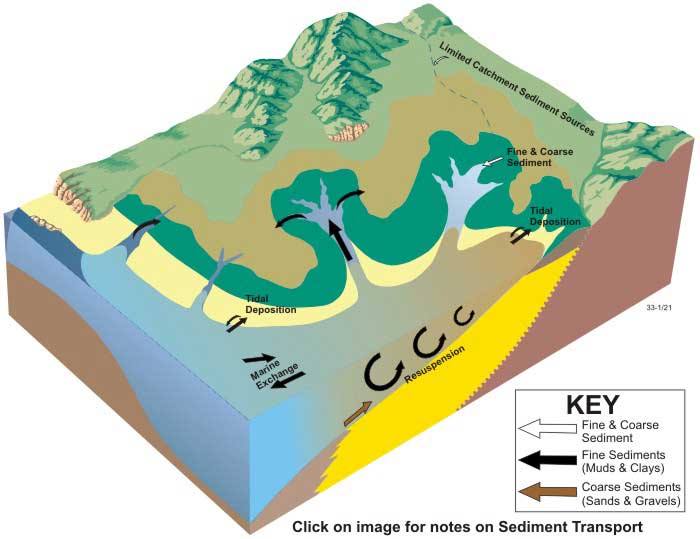
Sediment transport processes in tidal creeks
1. Sediment inputs from the catchment
Sediment inputs from the catchment are less important in tidal creeks; significant input typically occurs during high rainfall events only. Most terigenous sediment tends to be fine, and is derived from sheet runoff and aeolian inputs. Landward movement of marine-derived sediment is more important in tidal creeks.
2. Fine sediment deposition and erosion
Fine sediment (including muds and clays) undergoes both deposition and erosion on the extensive intertidal flats (Dyer, 1998, Woodroffe et al., 1999, Masselink et al., 2000). Deposition is aided by biological activity such as burrowing and improved cohesiveness (Ruddy et al., 1998, Murray et al., 2002), whereas erosion is typically related to storms and tides (Dyer, 1998). Coarser material (sands and gravels) is also deposited on flanking environments by tidal currents and extreme runoff events. Over time, intertidal flats tend to slowly expand seawards (Nichols 1999, Green et al., 2001).
3. Suspended sediment
Large quantities of suspended sediment are characteristic of tidal creeks. Strong tidal currents continually resuspended and rework fine sediment in the channels, so that the water column is naturally highly turbid (Turner et al., 1994, Wells, 1995). Turbidity is especially marked during spring tides (Semeniuk, 1982). Ebb and flood tides can follow mutually-evasive channels (which periodically migrate), and currents may be powerful enough to cause scouring at the channel base, leaving gravel and bioclastic debris at the base (Nichols 1999, Green et al., 2000, Harris, 1988). Tidal creeks lack significant quantities of terrigenous sediment, and comprise predominantly marine sediment.
4. Mangrove environments
Mangrove environments, with interspersed tidal drainage channels, commonly flank tidal creeks, and serve as a depocentre for sediment (Boyd et al., 1992, Woodroffe et al., 1993, Barnett et al., 1997). Tidal asymmetry (high energy short duration flood and lower energy long duration ebb tides), baffling by mangrove vegetation, and percolation of tidal water through animal burrows result in rapid deposition of fine sediment, and accumulation of coarse sediment derived from the shelf. Over time, mangrove environments tend to expand onto and replace intertidal flats (Woodroffe et al., 1999).
5. Saltflat environments
Saltflat environments experience inundation only during king tides, during which some deposition of fine sediment occurs. Sediment in supra-tidal regions (including the floodplain) is mostly mud, and is deposited during high tides (Roy et al., 1981). Ebb tide waters often flow back to the main estuarine channel through tidal drainage channels.
6. Movement of coarse sediment
Typically, net movement of coarse sediment occurs in a landward direction, resulting in the slow infilling of tidal creeks by marine sediment from the continental shelf (Green et al., 2001, Bryce et al., 1998). During extreme rainfall events, small quantities of sediment may be exported to the marine environment. The ability of tidal creeks to trap catchment derived sediment is therefore moderate to low (Harris et al.).


